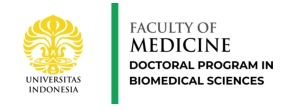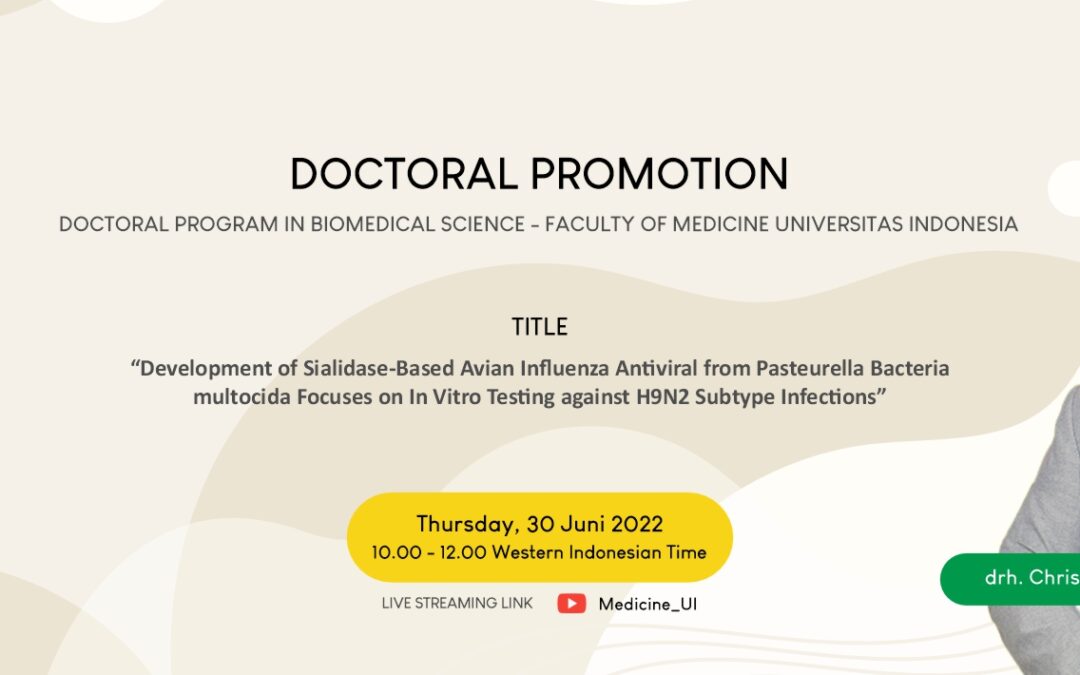Development of Sialidase-Based Antiviral Influenza of Bacterial Origin Pasteurella multocida Focusing on In Vitro Testing against H9N2 Subtype Infection
By: Dr. drh. Christian Marco Hadi Nugroho, M.Si
Avian influenza or also known as bird flu is an infectious disease caused by a virus that is easily spread by aerosol through the air. The bird flu virus commonly infects chickens, ducks, and various other types of poultry, and is reported to be capable of transmitting the disease to humans. Until now, various types of avian influenza viruses have been reported to cause disease in humans, such as types H5N1 and H7N9 which are a major problem in several countries.
Another type of avian influenza virus that can cause disease in humans and animals is H9N2. In Indonesia, the H9N2 type was first identified in 2015 and was reported to be at risk of infecting humans easily. Until now, H9N2 is still spreading in densely populated poultry farming areas. Although most cases of H9N2 in humans do not cause death, the public must remain alert to the possibility that changes in the virus can cause an increased risk of patient severity.
In preventing bird flu, vaccination is generally carried out, but vaccination often fails to prevent disease due to rapid changes in the virus, causing a mismatch between the virus in the vaccine and the viruses in the environment. On the other hand, treatment is carried out for avian influenza infection, namely using antivirals such as oseltamivir and amantadine, but based on research there have been many viruses that cannot be inhibited by these two types of drugs. Therefore, this study aims to prove the efficacy of sialidase from the bacterium Pasteurella multocida as an antiviral with a slightly different function from drugs in general, namely destroying the entrance of viruses located in target cells.
The study began by looking for bacteria that only had one type of sialidase, namely NanB, then optimization of the method that could produce NanB sialidase with the highest level of specific activity was carried out. Some of these methods are chloroform, glycine, freeze-thaw, and osmotic shock methods. After obtaining the optimum method, the propagation of NanB sialidase was carried out by this method and continued with purification of the sialidase through various chromatographic steps to produce pure sialidase which was proven qualitatively and quantitatively. The resulting sialidase was tested for its resistance to temperature, pH, and a certain length of incubation time. The research was continued by testing the toxicity and ability of NanB sialidase to eliminate the entrance of the virus on the cell surface. A challenge test with the H9N2 virus was also carried out to prove the effectiveness of the loss of viral entrance on the number of viruses that infect cells. On the other hand, the effect of inhibited viral infection was also tested by assessing the expression of p53 and Caspase-3 as determinants of programmed cell death.
The results showed that the chloroform method was the method that produced the highest specific activity, so crude sialidase was propagated using this method. The purification results showed an increase in the purity level of NanB sialidase after going through various stages of purification.
The NanB sialidase produced in this study was stable at pH 5 to 7 and a temperature of 37℃ although after three days of use there was a decrease in the efficacy of the sialidase. In general, sialidase is not toxic to red blood cells and MDCK cells. At a dose of 0.129 U/ml, NanB sialidase could eliminate the virus’s entrance into cells. At the same dose, the H9N2 avian influenza virus was successfully inhibited from binding to red blood cells and failed to enter and infect MDCK cultured cells. These results were also supported by the low expression of genes encoding cell damage at a dose of 0.129 U/ml.
In contrast to other viral drugs that act against the virus, sialidase acts more generally at the entrance known as sialic acid. The loss of the entrance causes inhibition of viral infection in cells so that cells are not damaged.
In conclusion, NanB sialidase from Pasteurella multocida bacteria effectively acts as an antiviral in inhibiting H9N2 infection in cells. However, further tests on experimental animals need to be carried out to obtain an accurate picture of the inhibition of avian influenza virus infection by sialidase. On the other hand, development efforts also require re-optimization of the sialidase purification method so that it can be applied easily and efficiently on an industrial scale.

